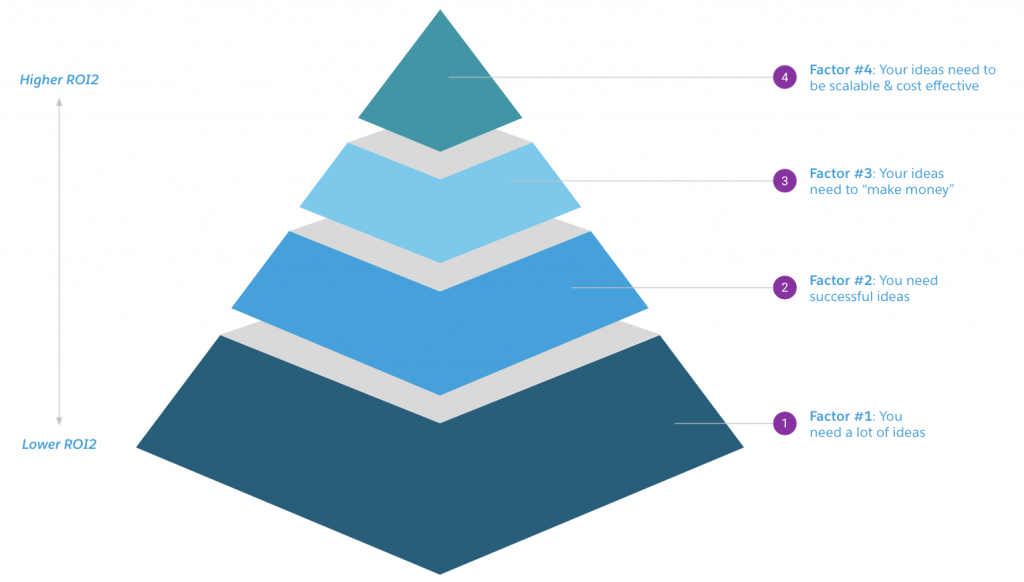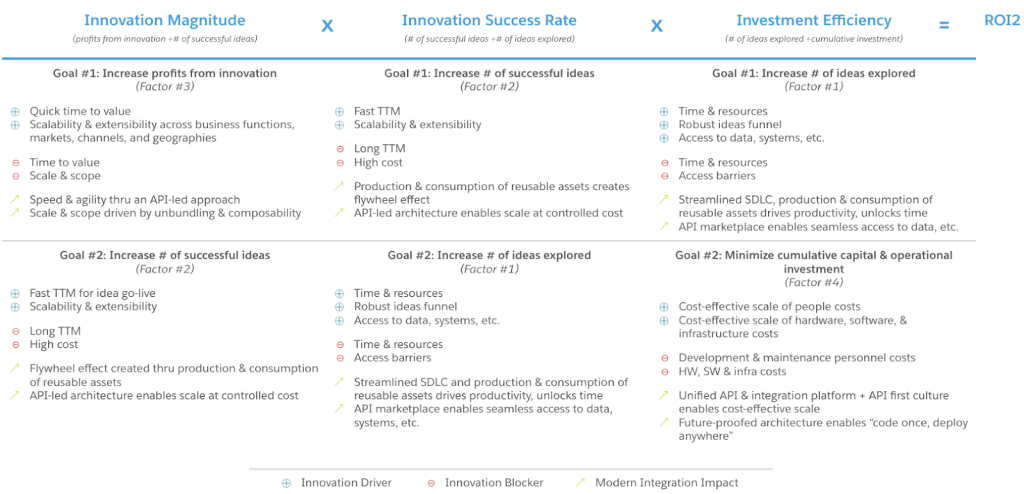Let’s start with some facts:
- Fact 1: Innovation is the lifeblood of organizations; upwards of 10% of revenues are spent annually on it and in some industries the percentage is even higher. According to Mckinsey research, global R&D expenses topped $2 trillion in 2019 (~2% of global GDP).
- Fact 2: Innovation spending is increasing as companies drive digital and omnichannel customer experiences, improve operational efficiencies with new technologies, and enable the “work from anywhere” paradigm. BCG analysis shows innovation is among organizations’ top three priorities — jumping 10 percentage points in 2021 compared to the previous year.
- Fact 3: Most innovations fail, leading to subpar-to-no ROI. And, as research shows, 94% of global executives are displeased with their innovation performance.
Organizations spend significant time and capital on innovation — but many fall short on tangible value creation and end up wasting both resources. There are numerous reasons why this happens: organizational risk aversion, misalignment, under-funding, slow time-to-market, idea inertia, and much more.
Lack of access to data, applications, systems, business processes, and infrastructure is one of the most common (and consequential) reasons for innovation failure. At a time where digital innovation is the most prevalent type of innovation — this is not just an IT problem, it’s a business problem.
But there’s hope. These access barriers can be eliminated through modern enterprise integration, which I defined in my first post of this series as 1) a business-focused integration strategy + 2) an operating model + 3) an API and integration lifecycle technology platform.

Figure 1: Three key elements to modern integration
In this post, I’ll break down factors that contribute to innovation and highlight how and where modern enterprise integration can deliver more impact.
The four factors of innovation
A logical way to measure innovation impact is to look at return on innovation investment (“ROII” or “ROI2”). Like any ROI or derivative metric, ROI2 identifies how much value an innovation contributes to the organization net of cumulative costs. It tells you the value outcome, but what it doesn’t tell you is how you got there.

Figure 2: ROI2 is really only valuable if you understand how you got there
For the same reasons organizations leverage DuPont Analysis to analyze factors contributing to their return on equity (ROE), organizations can analyze factors contributing to ROI2. Here are the four factors to analyze:
Factor # 1: You need a lot of ideas
Innovation starts with ideas. The hope is the more you have, the higher probability one of them will stick. There are two challenges organizations face when it comes to generating ideas:
- Time: Organizations don’t have enough time. For example, nearly 70% of IT’s time is spent “keeping the lights on” instead of innovating, according to MuleSoft’s 2021 connectivity benchmark report.
- Access barriers: Many ideas are dead before they are born because innovators can’t seamlessly access what they need, such as the right data or systems, to bring their idea to life.
Modern enterprise integration addresses the time challenge by making developers more productive. By streamlining the software development lifecycle (SDLC) with a unified API and integration platform and having reusable IT assets (APIs, code fragments), developers work faster and have more time to innovate.
Additionally, by creating a central marketplace of APIs that expose data and systems in a secure way, developers have access to the tools they need to innovate.
Factor #2: You need successful ideas
It’s not just about having ideas — you need ideas that deliver value. Generally speaking, a successful idea is one that contributes to your bottom line, one that is accretive rather than dilutive. Two common challenges organizations face in making ideas successful are:
- Long TTM: It takes too long to launch an idea to market.
- High cost: The idea costs too much to operate at scale.
An API-led approach creates a flywheel effect that can overcome the long TTM challenge. With this approach, developers produce assets and store them in a marketplace to be discovered and used for other innovation projects later on. This gets subsequent innovations to market faster as developers “compose” with assets that already exist (read MuleSoft CEO’s recent Wall Street Journal article).
The high-cost challenge can be overcome by limiting operational overhead and capital investment through code reuse and a future-proofed architecture (see Factor #4 below for more details).
Factor #3: You need your ideas to make money
Your idea must contribute to your organization by either increasing the top-line (revenue impact), decreasing cost (bottom-line impact), or some combination of both. Two key challenges organizations face in the pursuit of value creation are:
- Time to value: Benefits don’t grow fast enough to achieve a positive ROI within a suitable time frame.
- Scale and scope: Benefits don’t grow large enough to cover the costs and risks with pursuing the idea, or not enough is known about its potential to make it worth pursuing. Additionally, the benefits may be too narrowly focused and can’t extend widely within an organization (other business functions) or outside your organization (new markets, geographies, or channels).
API-led connectivity enables organizations to innovate with composable pieces (instead of point-to-point code), allowing you to launch an idea to market quickly and enhance/pivot on the fly at a fast clip — solving the time to value challenge.
By unbundling your organization into composable building blocks with an API-led connectivity approach, innovators can expand and extend innovations seamlessly into new value streams. This can lead to either direct monetization (selling APIs as products to buyers) or indirect monetization (stitching together various systems and processes with APIs to provide an improved customer experience), solving the scale and scope challenges.
Factor #4: You need your ideas to maintain a scalable cost footprint
It’s in an organization’s best interest to limit capital and operational investment as much as possible. Two key challenges organizations face when trying to scale an innovation are:
- People costs: Digital innovations that are built on point-to-point architectures require significant overhead to maintain, enhance, and scale.
- Hardware, software, and infrastructure costs: The hard costs can become exceptionally cost-prohibitive when scale and/or scope grows.
With modern enterprise integration, developers and innovators spend less time and money bringing an idea to market by having a unified platform and an API-first culture that promotes reuse. Additionally, they spend less time and money maintaining and enhancing their innovation once it’s live.
Hard costs can be brought down with a future-proofed architecture that allows organizations to scale vertically (more capacity to support demand), horizontally (extensibility across business functions, markets, channels, or geographies), and in the cloud, on-prem, or in a hybrid environment.
Looking at the four factors collectively, you get an ideas funnel that looks something like this, with the highest ROI2 coming from the top of the funnel:

Figure 3: The “ideas funnel” – the cream rises to the top
Making sense of the four factors, together
To take this analysis further, we must look at specific measures to understand how effective an organization is at delivering value from innovation, where to address challenges, and where modern enterprise integration can help. Specifically, there are three measures that make up the ROI2 equation:
Measure #1: Innovation magnitude
This measures the financial contribution of your innovations across all of your successful ideas, effectively giving you an average value per successful idea.

Figure 4: Innovation Magnitude
Measure #2: Innovation success rate
This calculates the rate at which you deliver a successful idea to market.

Figure 5: Innovation Success Rate
Measure #3: Investment efficiency:
This measures how cost effective your ideas are over time.

Figure 6: Innovation Magnitude
Multiply each of the three measures together, and you get both the value outcome — ROI2 — and the road traveled to get there.

Figure 7: Innovation magnitude x Innovation success rate x Investment efficiency = ROI2
Modern enterprise integration results in impactful innovation
Access to data and systems is often a significant challenge to successful innovation. Modern enterprise integration can help your organization break down these access barriers. As I’ve written in previous posts, both the business and IT must come together to form an enterprise integration strategy or risk paying the price downstream with innovation pursuits.
Take this four-factor approach to measure your innovation effectiveness. Look across each of the factors, identify where your organization does well, where there are challenges, and how and where modern enterprise integration can help. This should be an IT and business assessment, not one or the other.
MuleSoft can help you — our Mobilize advisory team works with organizations to establish business-focused integration strategies through our consulting engagements. Contact us today to begin your journey.
Next up in this blog series, we’ll be diving into the impact modern integration can have on business scalability within your organization.









